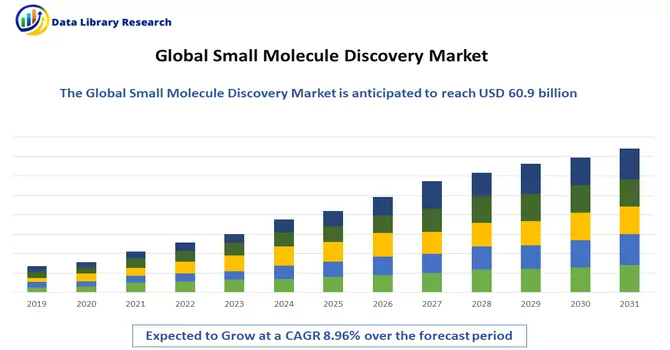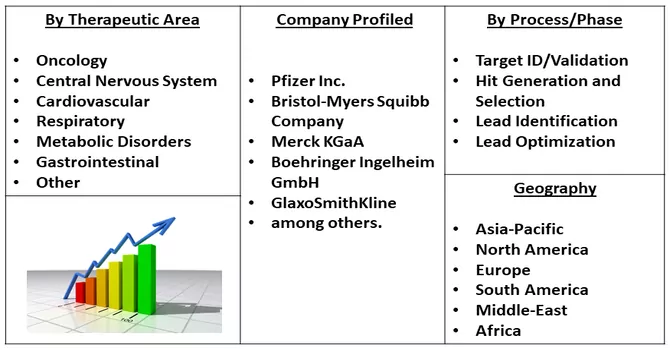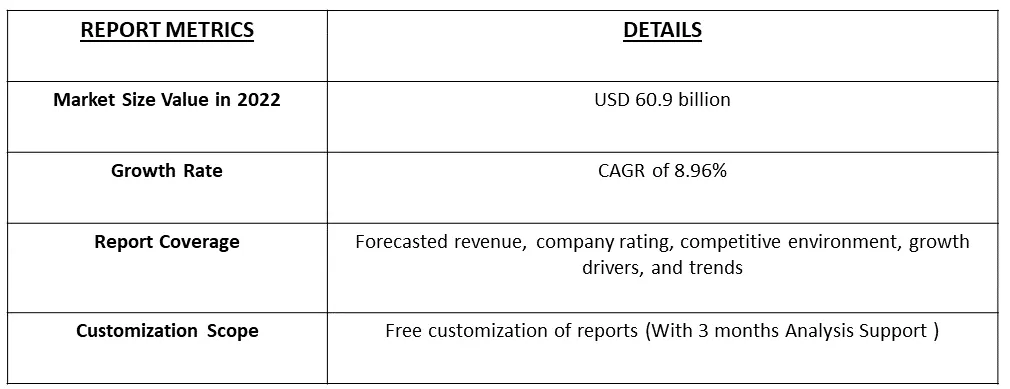The Small Molecule Market is currently valued at USD 60.9 billion in the year 2022 and is expected to register a CAGR of 8.96% over the forecast period.

Get Complete Analysis Of The Report - Download Free Sample PDF
Small molecule drug discovery represents all the costs incurred by a drug discovery company during the discovery phase. A small molecule is a substance that can enter cells quickly as it has a low molecular weight. These are used as drugs for therapeutic purposes and include chemically synthesized drug molecules and all biologically synthesized drug molecules.
The rise in demand for small-molecule drugs, an increasing number of contract organizations for research and development, and increasing usage of small molecules in the treatment of chronic diseases are expected to drive the growth of the market. The increasing number of chronic diseases propels the market's growth.
Small molecule drug development is experiencing increasing numbers of molecules in the pipeline on expedited regulatory pathways being developed by small and emerging pharma companies and a trend towards greater complexity of chemical structures and enabling technologies.
Another important development in 2022 was the reduced share of small molecules in new drug approvals. In 2022, 59% of the new drug approvals by FDA’s CDER were small molecules, significantly down from recent years—when small molecules accounted for approximately three-fourths of new drug approvals. In 2022, 22 of the 37 new drug approvals were small molecules, representing 59% of new drug approvals. In comparison, between 2018 and 2021, small molecules averaged 74% of new drug approvals. Thus, the market is expected to witness significant growth over the forecast period.
Segmentation:
The Small Molecule Drug Discovery Market is Segmented
By Therapeutic Area
By Process/Phase
Geography
The report offers the value (in USD million) for the above segments.

For Detailed Market Segmentation - Download Free Sample PDF
Drivers:
Rise in Demand for Small Molecule Drugs and Increasing Number of Contract Organizations for R&D
Healthcare costs are the main driver of the small molecule drug discovery industry. By providing medicines and vaccines for various medical operations, the pharmaceutical industry contributes significantly to healthcare. Therefore, the annual healthcare spending from corporate companies and government budgets has a big impact on the expansion of the drug discovery process. Healthcare expenses are rising quickly globally as a result of expanding insurance coverage. Due to an increase in patients, hospitals are increasingly in demand.
Furthermore, the recent developments are expected to fuel the growth of the studied market. For instance, in February 2020, a study published in Pharmaceuticals claimed that the FDA had approved the active pharmaceutical ingredients (APIs) for three peptides. Using artificial intelligence for medication research in the pharmaceutical industry is growing swiftly, according to a study published in BioPharma Trend 2020. This aspect is expected to boost the significant investment in R&D activities for identifying innovative therapeutic targets that will fuel market expansion.
Small Molecules in the Treatment of Chronic Diseases
Small molecule medicines can reach therapeutic targets inside cells. To treat a disease, a medicine must be able to reach a specific therapeutic target which in most cases is a protein associated with a specific biological process that can cause disease if it isn't functioning properly. The prevalence of numerous diseases like cancer/oncology, diabetes, and cardiovascular diseases is rising as a result of changing lifestyles, changing consumption patterns, poor eating habits, rising pollution levels, and physical inactivity. The International Agency for Research on Cancer estimates that there will be around 10.3 million cancer deaths and 19.3 million new cases of cancer worldwide in 2022. Thus, such instances are fueling the growth of the studied market.
Restraints:
High Drug Development Costs and Strict Regulations
In 2019, the Tufts Center for the Study of Drug Development estimated the cost of bringing a new drug from discovery to submission for approval at USD 6.6 billion. Thus, the high cost of drug development and stringent regulation may slow down the growth of the studied market.
COVID-19 Impact and Analysis
Segmentation Analysis
Target ID/Validation Segment is Expected to Witness High Growth Over the Forecast Period
Target identification is made to identify a small molecule's direct molecular target, such as protein or nucleic acid. In the case of clinical pharmacology, target identification is aimed at finding out the efficacy of the target of the drug molecule. The main objective of target validation is to identify and access the chances of a molecular target in achieving the development of pharmaceuticals for therapeutic application. Three key distinct and complementary approaches are used for target identification and validation: genetic interaction, direct biochemical, and computational interference. In many cases, combinations of multiple approaches may be required to characterize the target entirely. Thus, the segment is expected to witness significant growth over the forecast period.
The Oncology Segment is Expected to Witness Significant growth Over the Forecast Period
For the tumour cell, small molecules bind to proteins or nucleic acids and are designed to regulate the activity of the target by inhibiting its function or by disrupting specific protein-protein interactions. Thus, the use of small molecules in the treatment of cancer and the growing number of cancer cases is expected to drive the growth of the studied segment over the forecast period.
North America is Expected to Witness Significant growth Over the Forecast Period
North America currently dominates the overall market for small molecule drug discovery market owing to the rising cases of various chronic diseases, such as cardiovascular disease, cancer, etc., and increasing approval of new small molecules in the region. According to the American Cancer Society's 2022 statistics, it is estimated that in 2022, there will be 1,918,030 new cases of cancer in the United States, of which 983,160 will be among males and 934,870 will be among females. Furthermore, according to the Canadian Cancer Society 2022, there will be 233,900 new cancer cases in Canada in 2022. Such a high burden of cancer is expected to drive the market's growth as small molecules are primarily employed in the treatment of cancer.

Get Complete Analysis Of The Report - Download Free Sample PDF
Competitive Landscape:
The small molecule drug discovery market is moderate in nature due to the presence of a few companies operating globally as well as regionally. The competitive landscape includes an analysis of a few international as well as local companies that hold market shares and are well-known including
Recent Developments:
1) August 2022: BioDuro-Sundia and X-Chem, a DEL technology pioneer in small molecule drug discovery, launched DNA Encoded Compound Library (DEL) technology services in China to help more innovative pharmaceutical companies quickly discover small molecule drugs.
2) July 2022: RxCelerate launched RxNfinit. It is a new small molecule discovery platform that leverages machine learning, in silico structure modeling, and combinatorial chemistry in a novel workflow to offer significant advantages over the current generation of tools to identify small molecule drugs against a wide range of protein targets.
Q1. What is the current Market size Small Molecule Market?
Small Molecule Market is currently valued at USD 60.9 billion.
Q2. What is the Growth Rate of the Small Molecule Market?
Small Molecule Market is expected to register a CAGR of 8.96% over the forecast period
Q3. Which is the leading Component Segment in the Small Molecule Market?
Onology is the leading Component Segment in the Small Molecule Market.
Q4. Which are the major companies in the Small Molecule Market?
Pfizer Inc., Bristol-Myers Squibb Company, Merck KGaA & Boehringer Ingelheim GmbH are some of the major companies in the Small Molecule Market.
Data Library Research are conducted by industry experts who offer insight on industry structure, market segmentations technology assessment and competitive landscape (CL), and penetration, as well as on emerging trends. Their analysis is based on primary interviews (~ 80%) and secondary research (~ 20%) as well as years of professional expertise in their respective industries. Adding to this, by analysing historical trends and current market positions, our analysts predict where the market will be headed for the next five years. Furthermore, the varying trends of segment & categories geographically presented are also studied and the estimated based on the primary & secondary research.
In this particular report from the supply side Data Library Research has conducted primary surveys (interviews) with the key level executives (VP, CEO’s, Marketing Director, Business Development Manager and SOFT) of the companies that active & prominent as well as the midsized organization
FIGURE 1: DLR RESEARH PROCESS

Extensive primary research was conducted to gain a deeper insight of the market and industry performance. The analysis is based on both primary and secondary research as well as years of professional expertise in the respective industries.
In addition to analysing current and historical trends, our analysts predict where the market is headed over the next five years.
It varies by segment for these categories geographically presented in the list of market tables. Speaking about this particular report we have conducted primary surveys (interviews) with the key level executives (VP, CEO’s, Marketing Director, Business Development Manager and many more) of the major players active in the market.
Secondary ResearchSecondary research was mainly used to collect and identify information useful for the extensive, technical, market-oriented, and Friend’s study of the Global Extra Neutral Alcohol. It was also used to obtain key information about major players, market classification and segmentation according to the industry trends, geographical markets, and developments related to the market and technology perspectives. For this study, analysts have gathered information from various credible sources, such as annual reports, sec filings, journals, white papers, SOFT presentations, and company web sites.
Market Size EstimationBoth, top-down and bottom-up approaches were used to estimate and validate the size of the Global market and to estimate the size of various other dependent submarkets in the overall Extra Neutral Alcohol. The key players in the market were identified through secondary research and their market contributions in the respective geographies were determined through primary and secondary research.
Forecast Model
